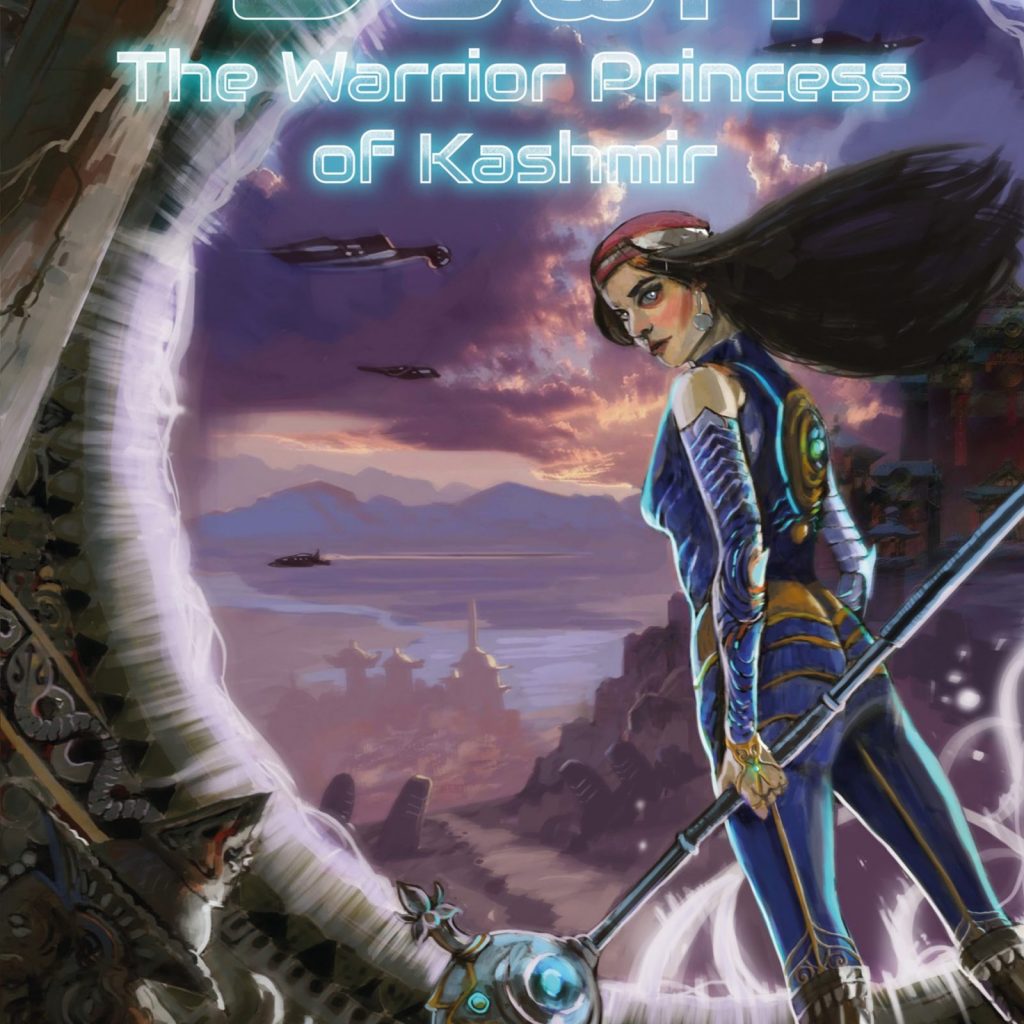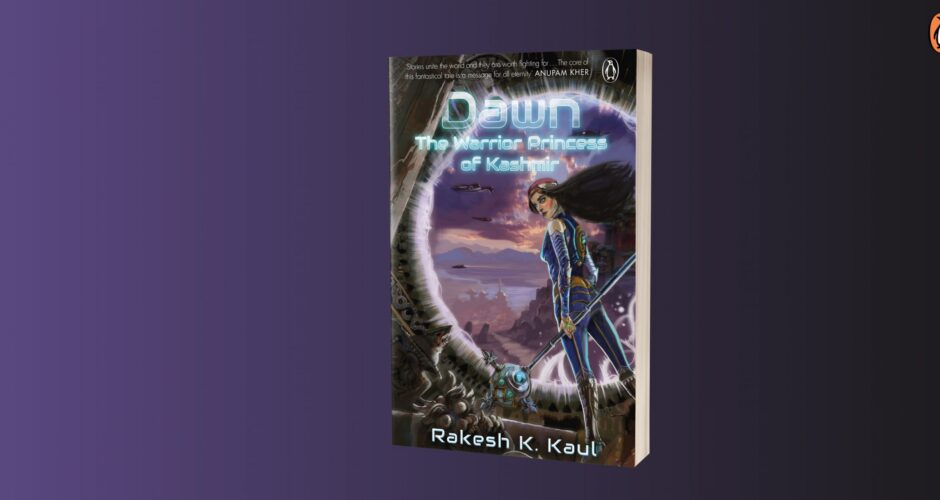Reclaiming Humanity in ‘Dawn: The Warrior Princess of Kashmir’ by Rakesh K Kaul Kashmiri Pandits around the world recently celebrated their most important festival of the year. It is Herath. And most Pandits are caught, like the outlaws of Rakesh K Kaul’s novel, Dawn The Warrior Princess of Kashmir, in small pods, far from their ancestral lands. They must do this as they face precarious times and cannot return to their homes. The longer their ancient, indigenous culture faces the intrusion of the outside world, the more likely their descendants will become assimilated into the dominant paradigm of the West.
With this comes the destructive ideology of patriarchal dualism. This historical context is the backdrop for Dawn. The story is a battle, informed by Mahabharata and the folktales of Kashmir. It draws from the world’s major traditions, revitalising original elements later buried under this dualist model. Expertly woven are historical, philosophical and cultural teachings from the unique traditions of Kashmir. The plot is non-linear, set across several millennia, between natural, spiritual and bio technically augmented realities.
The story and its setting is of seminal significance for the billion Hindus and a must read. This review seeks to provide the deeper import of the story without being a spoiler. The heroine, Dawn, is the daughter of two incompatible forces: one affirming life and the other, death. The story begins on the day of Dawn’s sixteenth birthday, in the year 3000. Maej, Dawn’s mother, is a biological scientist. She raises her from a small child in a cave at Mt Kailash, surrounded by a firewall.
They live an enchanted life, sustained by advanced technology, eating from interior gardens supplemented with stored goods. Dawn is raised on Kashmiri Niti stories. These oral teaching devices result in self-reflexive responses that catalyse self-development. Before long, Dawn’s ideal life is disturbed as she is told about a prophesy in which she must save life itself. Yuva, an elephant headed youth, enters Dawn’s room, without setting off alarms, on her first day as a sixteen year old. He has a little bird upon his shoulder who is also sixteen, much to Dawn’s confusion.
Yuva lets the secret out, about her true identity, and takes Dawn’s ‘cognition twin’ out to meet her first friends. They are five boys, named the Pandavas. Their General will this time be Dawn. Together, with the help of Yuva and Maej, the youth are set to training. They must hone martial, spiritual, logical and emotional strengths intrinsic to each character. Niti stories are essential to their training as they cannot fight on strength alone and must use their wits and spiritual powers to defeat an enemy whose only chink is inhumanity.

Throughout the story it is Dawn’s inner light that comes to the fore and her female powers. And although she requires the brains, and brawn of her warriors, without her, the battle cannot be won. Dawn struggles with inbuilt inferiorities, being ‘just a girl’, and ‘alone’, although she likes the feeling of empowerment and understands it is indeed her duty as the last female on the planet to restore balance and obtain justice. Her character is based upon the most powerful Goddess of the tantric tradition, that of the virgin, Kubjika.
She is the reproductive power of the universe, perfectly self-sustaining, without any need for a male. This is of itself a major threat to male ego. Even when that male ego is embedded in the female antagonist, AIman. In Kashmiri tradition, Maha is Lord Shiva, and his power is Shakti. Without her, he is dead. And in the process of cultural evolution, the power of the feminine has progressively been stripped out of world traditions, leaving a barren and lifeless trajectory of dead matter and disembodied mind. Dawn challenges male domination, just by her existence.
Her organic life force energy, signified by and obtained through life breath, cannot be replicated by AI. Awakening her innate powers, the kundalini shakti, unites Dawn with the reproductive powers inherent in her, a macrocosm and non-different to the universal power of life itself. By setting Universal Life in the novel, against Universal Information, we see an imaginative illustration of the second verse of Shiva Sutra: knowledge is bondage.
We also see in its biotech outcomes, a terrifying parallel in today’s culture. It is not difficult to see the link between today’s transhumanist industrial development and the historical reification of the masculine by the rejection of the feminine. This is the overarching warning of this story.
However, Kashmir Shaivism holds a key to overcome it by the disproportionate capacity of women to attain the ultimate state, which transcends time and space. It is said, and in the novel Dawn, that a woman achieves in twelve days, what it takes a man one year. This is due to their intrinsic capacity to bear life, and to be synchronised with cosmic forces.
This trope repeats throughout. We see this new Kurukshetra in the light of the Bhagavad Gita immediately. Except here, Dawn, displaces Arjuna’s traditional authority with that of a sixteen-year-old virgin. And she isn’t Draupadi who marries any of them.
They serve her as their General without any promised reward, which is the core teaching of the Gita. Relationships are thereby complicated, as even her mother has left her psychopathic husband with the sexbot that replaced her. Dawn is not about to become the mother of any future race either, which is a tension throughout the whole story. The linear thinking goes that to save life Dawn must bear it.
It is a troubling outcome for consistency. The truth is told early by Maej: that everything must die. And to live is not only to recreate bodies. Universal Information assumes the role of God to create from the body of nature, new bodies that are disconnected from her agency, produced in laboratories and injected with human character and its flaws. AIman, replicates the narcissism of her father, and as consort, combines only those features of femininity that meet the carnal desires of men. It is this that eventually leads to their downfall. Had Dawn simply become Eve with the Pandavas, it would replace man’s dominion with that of a woman and repeat in reverse the same primary error. It would reduce her rather than Adam, to the source of the human race, thus finally martyring her autonomy to her reproductive organs. It would be reversed phallogo-centrism.
That conflicts with the central teaching of Shaivism, that spiritual attainment grants unlimited potentials inscribed with svātantrya, absolute freedom and autonomy. It is not a woman’s physical, biological capacity that most challenges male supremacism. It is her spiritual power, which tantra holds as connected to the reproductive powers of the entire universe. It is only through Shakti, and not the mere suppression of thought, that the mind is truly elevated to full emancipation in Kashmiri tantra. This is discussed in the novel through the concept of rasa. Although Patanjali’s sense of one-pointedness is central to Kashmir Shaivism, it is not obtained by the negation of senses, or the renunciation of worldly activity.

The Warrior Princess of Kashmir’
It is necessary to have the control of the senses and mind otherwise we are no different to automaton machines. However, when spirituality is entirely cut off from living reality, it becomes sterile.
This is most evident in the diminishment of female deities, and the deprivation of female agency in the world’s spiritual traditions.
Concomitant is the binding of that power, by domestication and subversive elevation of women only to the extent they bred sons for fathers and serve the interests of men. It is the spiritual power of women, inclusive of their equal intelligence to men, that becomes the ‘more than’ to this story’s parts. Achieving that through the ancient trope of the virgin goddess, who brings life without any input from men and who is God, not just his product, Rakesh K Kaul has uttered secret truth.
For Kubjika, even a male’s contribution to fertility, is only her emission. It reminds us that both men and women are the products of the same Mother Nature who is capable of asexual reproduction, for example, cloning. It asks us to set our sights higher when imagining the creativity of natural evolution which never simply replicates some perfected form, as it seeks continuous biological diversity and manifests as multiplicity. It may sound counter intuitive, that monism is not monoculture and that monoculture stems from dualism.
The spiritual view of the feminine principle acknowledges that Universal Life is not the mere information of laboratory reproduction and DNA sequencing. Once it is lost in humans, we will become, whether female or male bodied clones, something entirely other: ~human. The battle is close to the author, who is the grandson of the great Kashmiri yogic mystic, Pandit Gopi Krishna, mentioned in Dawn as a kundalini master. It is in Dawn’s blood that her capacities are dormant and must be awakened. The story broadens the potentializing from bloodlines by positing the likelihood that Kashmiri mitochondrial DNA may be present within many descendants of Genghis Khan and his hordes. They bred with 40,000 women stolen from Kashmir.
This is a twist in the plotline with far deeper meaning as the powers of Universal Life are in fact embedded in all biological, but not technological, forms. The closest thing a machine can come to vitalism is mimicry. Kashmiri Hindu culture is almost exclusively monistic and exalts the power of Shakti. Aside from the name Shaivism, it is predominantly about Shakti, not Shiva. It is one of the last surviving indigenous traditions to do so. Kashmir Hindus are experiencing an ongoing cultural genocide due to their seventh ethnic cleansing in as many centuries.
To take one small case to imagine the impact, Herath, is to be practiced in winter, prepared for long in advance and would span a month in total. Those in Kashmir, who still practice the shortened, ten-day rites, are reduced to just a few families. For the estimated half-million in exile, if repatriation is not quickened, this may be the last generation who learnt their traditions on their soil. The observances are presently, for most families, reduced to one evening. It is impossible to obtain the necessary ingredients or perform their entire customs in exile. No different to the exile of Tibetan Buddhists, it is their Dharmic beliefs that the colonisers have sought to eradicate and replace.
In Kashmir, Islamists have converted 97% of the indigenous peoples, less than 1% remain. This is also similar to the conversion of pagans in Europe, natives of America, indigenous Australians, etc, except over seven centuries. For Kashmiri culture and traditions to survive, will demand commitment from outside their community, who are the most vulnerable population of Kashmiris. India needs international support to bring the perpetrators to justice, establish safety for return and to re-educate the colonising class on the importance for contemporary society of truth, reconciliation and inclusivity.
Like any indigenous culture, Kashmiri traditional knowledge systems are inseparable from and dependent upon the land. In the absence of the rivers, lakes, mountains, animals, fruits, nuts, flowers and herbs, the correct offerings cannot be made to the in-situ deities, because the deities themselves are occupying, and even are, the natural landforms. Each of the stories, the philosophy, and the customs, are grounded in the ecological backdrop of this Himalayan Valley. Herath is discussed in the 6th Century Nilamata Purana which will verify this claim that the culture is not transportable. Although a small fragment of Kashmir Hindu culture, Kashmir Shaivism, is being dissected and analysed in Ivy League Universities, almost forensically, it is entirely apart from the culture. It is in the manner of the Universal Information scientists.
And though we hear the word, pasted onto degrading ‘tantra yoga’ workshops, Kashmir Shaivism is hardly understood. In Kashmir it is partly because its essence is sublimated into the ordinary culture of Kashmiri Hindus to the point of forgetting the philosophy behind the rites. More significantly though is the sustained attacks that restricted Kashmiri Hindu’s capacity to conduct their traditions in their own temples, on their traditional lands and in public, without penalties. This is a global problem because they claim as is proven by the Sanipatul that they worship during Herath, and there is no reason to refute, they are one of the last directly continuous lineages with the Indus Valley civilisation. Nilamata Purana explains the obligations of every strata of the peoples of Kashmir to the deities that abide in the land and the ancestral custodians the Nagas.
As Dawn states, Kashmir is said to have been once submerged by a lake. It was drained by Lord Shiva, dashing down his trident to reveal and conquer a hidden demon named Jalodbhava. The archaeological record says that Baramulla Pass, which opened up the Vitastha river, formed 70-80K years ago from a violent earthquake. There are thousands of ancient naga sites there, more than any other form of worship as well as the place name ending of nag, which is often by a ‘spring’. The association of nagas with lingams, with Shiva, tantra and kundalini is well understood.
What is not understood by the west in general, that iconography and archetypes are directly connected to nature worship and the land. Springs, rivers and lakes are all associated with nagas. Shiva is known as the king of the Nagas, we have Nagarjuna, the Kashmiri Buddhist, and Patanjali is known as Adi Shesha, the serpent like form of Lord Shiva and founder of yoga.
The serpent is however, also Shakti. Association of nagas to water is about life breath, spiritual energy flowing through our biological bodies. It is intrinsically fertile, creative and intelligent but on another dimension to animal instinct and materialism. The process requires the equalisation and harmony of both her masculine and feminine ‘rivers’, Ida and Pingala so that her central channel can be entered. She is the force that binds us all to life, which elevates us when we are ripe, to liberation.
She is the force, embodied by Dawn who carries us into the realms beyond time and space, represented by Mahadev. Kundalini is powerful because she contains within her the entire spectrum of polarity, their balance and beyond. This cannot ever be realised by a humanity intent on separating these two forces. It is only through the elevation of both to the same exalted state that humanity will truly teach its potential. And to fulfill that, Dawn provides a road map to overcome the fear of women, understand this serpent power, and, the living traditional knowledge systems, like Kashmir Hindu tantra have survived to show us how. Dawn is a Niti story, perfect for Kashmiris in exile to remember their incredible roots. It is also a Niti story for humanity.
The micro and the macro here, are drawn seamlessly together like a tree inside a seed. Though this review has focused on Dawn, to analyse the paradigm that she represents and to situate the social commentary, there are plenty more fresh and charming details, many more characters rich with symbolic readings. Overall, this book stands up with classic works like Brave New World, from other prophets of science fiction. Yet it gives us more than stories. It gives us, like Niti, the tools to tell another tale. Rakesh K Kaul continues the legacy of sublime Kashmiri literature.
As he says, it’s in the blood. By reading, sharing and promoting this book you become part of the solution. That could only be improved by independent funding for an independent film. This story is too precious to lose its life force with which it is surely a cult classic with a very strong, indigenous female lead. It is what humanity desperately need to hear and a pledge we all must take.
Book Review by Sarah Louise Gates
Sarah Louise Gates is an Australian Cultural Studies PhD Candidate, Kashmir Shaivite Hindu and yoga instructor, finalising her “thesis of interconnectedness” in yoga and eco-social justice. Courtesy The Indian Eye



























